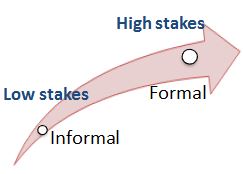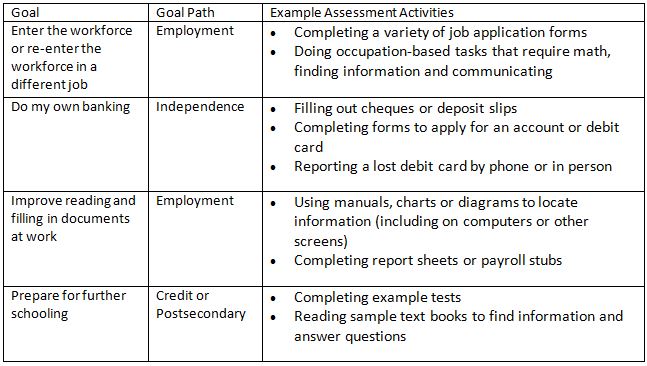 Methods of Assessing
Methods of Assessing
Assessment is not an isolated event that takes place only at intake. From the time clients enter our doors, through their time spent as learners, until they exit and move on to the next stage of their goal path, we observe and assess their actions and reactions. We make decisions based on our assessment observations and we help the learners make decisions, too.
Informal Assessment
Much of our assessment happens at an everyday, casual level using tools that are often unique to the program and the learner. This can be referred to as “informal” assessment. Informal assessment is part of the ongoing relationship between literacy staff, volunteers and learners. It helps to indicate what the next steps are in the learning process. However, when seeking a common understanding of assessment results for all stakeholders, we need more formalized tools.
Formal Assessment
Formal tools are more widely recognized than those developed in your local literacy program. Formal tools have usually been developed by experts and have undergone careful validation processes to ensure that they are accurate and provide consistent results.
Using Formal vs. Informal Assessment
So, if the formality of assessment tools varies, how do we decide when to use a formal or informal type of tool? It comes down to the importance of the assessment or the consequences placed on the outcome. For low-stakes decisions (for example, if the purpose of the assessment was deciding what activities the learner should work on next or whether a learner is ready to move on to learning activities at a higher level in the program), then informal assessment tools are usually sufficient. In these cases, informal assessment is often less stressful for some learners. In situations where the assessment results may be significant to a stakeholder (for example, the learner’s next step is secondary or postsecondary school or employment), a formal assessment would be preferable. In these cases, ensuring that learners are ready to move on to the next step is important for both the learners and the institution or employer.

Formal Assessment Tools
The OALCF does not endorse a single, specific method of assessing literacy learning. Instead, it encourages LBS agencies to use a variety of tools and methods appropriate to learners’ interests, needs and goal paths. During the development of the OALCF, in February 2011, a sampling of 25 appropriate, formal assessment tools was provided in the MTCU publication Ontario Adult Literacy Curriculum Framework Selected Assessment Tools. Each resource listing provides a description of the tool, how to use the tool, its range of formality and where to get it.
Standardized tests are always given and scored in the same way. Test results for each learner are compared to the performance of a group that has been declared the norm. Because of the stringency required in their development and administration in order to maintain consistent and valid results, standardized assessment tools are often expensive to purchase or use. They may require training and licensing or certification to administer. For these reasons, standardized tests were not included in the OALCF Selected Assessment Tools list. This does not mean that standardized tests are not to be used for LBS assessment. In fact, several are listed as possible assessment tools on the LBS Participant Registration Form. Some examples of standardized tests commonly used in LBS programs are:
- CAAT (Canadian Adult Achievement Test)
- CAMERA (Communications and Math Employment Readiness Assessment
- PDQ (Prose, Document, Quantitative)
- TOWES (Test of Workplace Essential Skills)
Since the publication of the OALCF Selected Assessment Tools, many organizations have articulated their tools to the OALCF. One example of this is Literacy Link Eastern Ontario’s project, Aligning Literacy Link Eastern Ontario’s Assessment Tools (ALAT). This project articulated their previously published assessment tasks/activities to OALCF Competencies and Levels. Below are the names of the ALAT tools.
- Aligning LLEO’s Assessment Tools User Guide
- CABS Online Alignment
- CABS CAES Alignment
- WESA Alignment
Although not specifically intended for OALCF use, assessment tools that are articulated to the Essential Skills may also be useful in LBS programs, especially for learners on the Employment and Apprenticeship goal paths.
Through professional development and your local Literacy Services Planning and Coordination (LSPC) committee, you may find other formal assessment tools that are suitable for OALCF assessment for your community, your program, and, of course, learners.
Authentic Assessment
Authentic assessment uses real-world or authentic documents and tasks for assessment. The learners’ abilities are demonstrated using actual work, training or life-related tasks simulating how a person would use the documents or complete a job task. This type of assessment can be particularly useful for ongoing assessment. Authentic assessment is often incorporated into integrated tasks.
Authentic assessment resources should be relevant to the learner’s goal. See the chart below for examples.

You can find authentic documents to use for assessment purposes by visiting employers, by clipping articles from newspapers or magazines, or by picking up forms and pamphlets from doctors’ and lawyers’ offices. Gathering authentic materials for a variety of learners can be very time-consuming for individual practitioners.
So you might use those already developed by other practitioners at
- Task-Based Activities for LBS is a database of hundreds of activities aligned to the Ontario Adult Literacy Curriculum Framework (OALCF) by LBS practitioners. These activities can be used to assess learners’ skills or to practise skills they are learning.
- The Common Assessment for the Ontario Adult Literacy Curriculum Framework Paths (CA-OALCF) Resource Package provides LBS service providers with tools and information for assessment activities for all 5 Goal Paths, 6 Competencies and 3 Levels. There are task-based sample activities that can be used for various assessments (initial, ongoing, exit).
Questions and Activities for Reflection
- Why would you use different assessment tools depending on the learner’s goal or literacy level?
- Make a chart of the assessment tools you presently use. Include the tool name and the competencies, levels and goal paths for which it is most suitable. Now rate them using the informal – formal range. Where do most of your tools fall on the range?
- Consider a learner you have worked with or imagine a learner profile (examples – learner wants to be a room painter and needs to improve Find & Use Information, or learner wants to know how to eat healthier and wants to improve Find & Use Information). What authentic task(s) and authentic document(s) could you develop for the learner?
- Talk your answers over with another literacy practitioner in your program or community.
- Have a discussion around these questions with one or more other literacy practitioners.




